Zoom
Trash

The Elemental Union. Roman Army Tactics. Roman Tactics Information about tactics can be derived from accounts of battles, but the very military manuals known to have existed and to have been used extensively by commanders, have not survived.

Perhaps the greatest loss is the book of Sextus Julius Frontinus. But parts of his work were incorporated in the records of the historian Vegetius. The importance of the choice of ground is pointed out. There is an advantage of height over the enemy and if you are pitting infantry against cavalry, the rougher the ground the better. In the battle line, each man should have three feet of space, while the distance between the ranks is given as six feet. Military Strategy and Tactics. Military strategy and tactics are essential to the conduct of warfare.
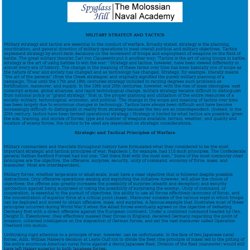
Broadly stated, strategy is the planning, coordination, and general direction of military operations to meet overall political and military objectives. Tactics implement strategy by short-term decisions on the movement of troops and employment of weapons on the field of battle. The great military theorist Carl von Clausewitz put it another way: "Tactics is the art of using troops in battle; strategy is the art of using battles to win the war. " Strategy and tactics, however, have been viewed differently in almost every era of history. The change in the meaning of these terms over time has been basically one of scope as the nature of war and society has changed and as technology has changed.
Strategic and Tactical Principles of Warfare Military commanders and theorists throughout history have formulated what they considered to be the most important strategic and tactical principles of war. Body Parts of the Horse. 1) Poll; The poll is the bony prominence lying between the ears.

Except for the ears, it is the highest point on the horses body when it is standing with its head up. 2) Crest; Moderately lean in mares but inclined to be more full in stallions. Curved topline of the neck. 3) Forehead; The forehead should be broad, full and flat. 4) Nostrils ; The nostrils should be capable of wide dilation to permit the maximum inhalation of air, yet be rather fine. Describing a Person or Place. The more I get to know her, the more I realize she has low self-esteem.
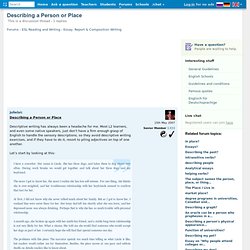
For one thing, she thinks she is over-weighted, and her troublesome relationship with her boyfriends seemed to confirm that fact for her. At first, I did not know why she never talked much about her family. But as I got to know her, I realized they were never there for her. Her lousy dad left her shortly after she was born, and her depressed mom was always drinking.
Perhaps that is why she has so much trouble with personal relationship. A month ago, she broken up again with her ninth boy friend, and a stable long-term relationship is not very likely for her. Words to Describe a Person. In our daily lives, we come across a lot of people with whom we may or may not interact. A few of them become acquaintances and some even become friends over time. Then again, there are some that give off unfavorable vibrations or are simply repulsive. Also, in our social circles, we have friends, relatives, colleagues, seniors, etc., each of whom has a unique set of attributes that are a part of his/her individual personality. These attributes are often highlighted to summarize an individual's personality or most striking trait. Below is an alphabetical list of words that can be used to describe a person in terms of his/her qualities and the impression he/she has left on you.
Describing a person - adding descriptive elements and well-chosen details. English words that describe behaviour. An A-Z of English words and phrases that describe behaviour.
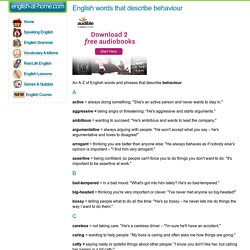
The 100 Most Important Things To Know About Your Character (revised) Quote from original Author(Beth):This list came about when, one day while struggling to develop a character for an upcoming Hunter game, my lovely roommate Nikki looked at me and said something like, "Wouldn't it be cool to have a list of questions you could go through and answer while you were making characters, so you'd make sure to consider all sorts of different elements in their personality?
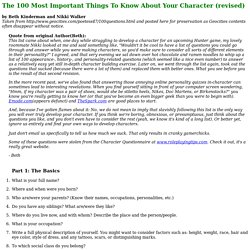
" I agreed, and that very evening we sat down over hot chocolate and ramen noodles to whip up a list of 100 appearance-, history-, and personality-related questions (which seemed like a nice even number) to answer as a relatively easy yet still in-depth character building exercise. Later on, we went through the list again, took out the questions that sucked (because there were a lot of them) and replaced them with better ones.
Ambiguous Words. HOW TO WRITE GOOD. Caveat emptor.
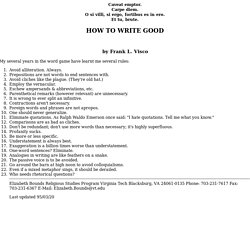
Carpe diem. O si villi, si ergo, fortibus es in ero. Et tu, brute. by Frank L. Visco My several years in the word game have learnt me several rules: Avoid alliteration. Word Count Tool - Free Online Tool to Count Number of Words. 23 Websites that Make Your Writing Stronger. We are all apprentices in a craft where no one ever becomes a master.

~Ernest Hemingway How strong is your writing? Precise Edit: Expert editing, proofreading, and manuscript assistance.
Bodycard 0126.